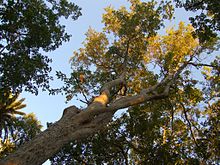|
Acer oblongum
Acer oblongum, common name Himalayan maple, evergreen maple and Kashmir maple,[4] is an evergreen Asian species of maple in the family Sapindaceae. DescriptionAcer oblongum is a medium-sized evergreen to semi-deciduous tree reaching a height of approximately 15–22 metres (49–72 ft). Unique among maples, this plant stays green all winter. The trunks are buttressed, with a smooth to wrinkled bark. Leaves are opposite, ovate-lanceolate with entire margin, with a petiole 5–12 cm long, with glaucous-green underside and dark green upperside. The young shoots are reddish bronze and finely hairy. The flowers are hermaphroditic, small and inconspicuous, about 4 mm, greenish white, gathered in hairy racemes. The fruits are represented by the typical two-winged samaras, about 2.5 cm long, wind dispersed. It has been introduced for its wood and it is sometimes cultivated in large gardens for its evergreen foliage.[5] DistributionAcer oblongum is widespread across central, eastern, and southeastern Asia, from Tibet and northern India east as far as Japan, including southern China, and northern Indochina.[6] VarietiesThree varieties are accepted.[2]
HabitatAcer oblongum prefers humid climate of the Himalayan forests, especially along streams, at an elevation of about 600–2,000 metres (2,000–6,600 ft) above sea level.[7] References
External links
|
||||||||||||||||||||||||||||||||||||||||||||

